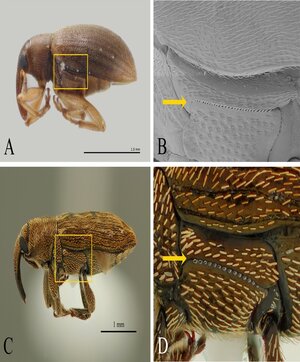Generación de imágenes digitales de alta resolución de artrópodos: soluciones pensadas para colecciones en Latinoamérica
Contenido principal del artículo
Resumen
Las colecciones biológicas son importantes reservorios del patrimonio biológico. Estas instituciones desarrollan esfuerzos constantes para preservar y estudiar los especímenes que custodian, así como para hacer disponible la información que acompaña a dichos ejemplares. Los avances tecnológicos recientes les han brindado a las colecciones científicas una enorme capacidad para producir imágenes que facilitan alcanzar los objetivos de preservación y divulgación. Sin embargo, la generación de imágenes de alta resolución es vista como un proceso con alta demanda de equipos y elevada inversión presupuestal, lo que dificulta su implementación. Por ello, en este trabajo se sintetizan los requerimientos y los pasos necesarios para obtener, procesar y almacenar imágenes de artrópodos, proponiendo soluciones de diferentes costos que pueden ajustarse a las necesidades y realidades de las colecciones entomológicas latinoamericanas y de sus potenciales usuarios.
Descargas
Detalles del artículo

Esta obra está bajo una licencia internacional Creative Commons Atribución-NoComercial-CompartirIgual 4.0.
Citas
Allen, E. y Triantaphillidou, S. (2012). The Manual of Photography. Taylor & Francis Group.
Bäumler, F., Koehnsen, A., Tramsen, H. T., Gorb, S. N. y Büsse, S. (2020). Illuminating nature’s beauty: modular, scalable and low-cost LED dome illumination system using 3D‑printing technology. Scientific Reports, 10(1), 12172. https://doi.org/10.1038/s41598-020-69075-y.
Bevilaqua, M. (2020). Guide to image editing and production of figures for scientific publications with an emphasis on taxonomy. Zoosystematics and Evolution, 96(1), 139-158. https://doi.org/10.3897/zse.96.49225.
Blagoderov, V., Kitching, I., Livermore, L., Simonsen, T. y Smith, V. (2012). No specimen left behind: industrial scale digitization of natural history collections. ZooKeys, 209, 133-146. https://doi.org/10.3897/zookeys.209.3178.
Brecko, J. y Mathys, A. (2020). Handbook of best practice and standards for 2D+ and 3D imaging of natural history collections. European Journal of Taxonomy, (623). https://doi.org/10.5852/ejt.2020.623.
Brecko, J., Mathys, A., Dekoninck, W., Leponce, M., VandenSpiegel, D. y Semal, P. (2014). Focus stacking: Comparing commercial top-end set-ups with a semi-automatic low budget approach. A possible solution for mass digitization of type specimens. ZooKeys, 464, 1-23. https://doi.org/10.3897/zookeys.464.8615.
Buffington, M. L. y Gates, M. (2008). Advanced Imaging Techniques II: Using a Compound Microscope for Photographing Point-Mount Specimens. American Entomologist, 54(4), 222-224. https://doi.org/10.1093/ae/54.4.222.
Buffington, M. L., Burks, R. A. y McNeil, L. A. (2005). Advanced Techniques for Imaging Parasitic Hymenoptera (Insecta). American Entomologist, 51(1), 50-56. https://doi.org/10.1093/ae/51.1.50.
Doan, T-N. y Nguyen, C. V. (2023) A low-cost digital 3D insect scanner. Information Processing in Agriculture, 3. https://doi.org/10.1016/j.inpa.2023.03.003.
Eliceiri1, K., Berthold, M., Goldberg, I., Ibáñez, L., Manjunath, B., Martone, M., Murphy, R., Peng, H., Plant, A., Roysam, B., Stuurman, N., Swedlow, J., Tomancak, P. y Carpenter, A. (2012). Biological imaging software tools. Nature Methods, 9(7), 697-710. https://doi.org/10.1038/nmeth.2084.
Holovachov, O., Zatushevsky, A. y Shydlovsky, I. (2014). Whole-Drawer Imaging of Entomological Collections: Benefits, Limitations and Alternative Applications. Journal of Conservation and Museum Studies, 12(1), 1-13. http://dx.doi.org/10.5334/jcms.1021218.
Høye, T., Ärje, J., Bjerge, K. y Raitoharju, J. (2021). Deep learning and computer vision will transform entomology. PNAS, 118(2), e2002545117. https://doi.org/10.1073/pnas.2002545117.
iDigBio. (2023). Recommendations for the Acquisition, Processing, and Archiving of Digital Media. https://www.idigbio.org/wiki/index.php/Recommendations_for_the_Acquisition,_Processing,_and_Archiving_of_Digital_Media.
Kawada, R. y Buffington, M. L. (2016). A Scalable and Modular Dome Illumination System for Scientific Microphotography on a Budget. PLoS ONE, 11(5), e0153426. https://doi.org/10.1371/journal.pone.0153426.
Kerr, P. H., Fisher, E. M. y Buffington, M. L. (2008). Dome lighting for insect imaging under a microscope. American Entomologist, 54(4), 198-200. https://doi.org/10.1093/ae/54.4.198.
Lessard, B. D., Whiffin, A. L. y Wild, A. L. (2017). A Guide to Public Engagement for Entomological Collections and Natural History Museums in the Age of Social Media. Annals of the Entomological Society of America, 110(5), 467-479. https://doi.org/10.1093/aesa/sax058.
Martin, J. E. H. (1977). The insects and arachnids of Canada, Part 1. Collecting, preparing and preserving insects, mites, and spiders. Research Branch, Canada Department of Agriculture.
Mertens, J. E. J., Van Roie, M., Merckx, J. y Dekoninck, W. (2017). The use of low cost compact cameras with focus stacking functionality in entomological digitization projects. ZooKeys, 712, 141-154. https://doi.org/10.3897/zookeys.712.20505.
Porto, A., Rolfe, S. y Maga, A. M. (2021). ALPACA: A fast and accurate computer vision approach for automated landmarking of three-dimensional biological structures. Methods in Ecology and Evolution, 12(11), 2129-2144. https://doi.org/10.1111/2041-210X.13689.
Schuh, R., Hewson-Smith, S. y Ascher, J. (2010). Specimen Databases: A Case Study in Entomology using Web-based Software. American Entomologist, 56(4), 206-216. https://doi.org/10.1093/ae/56.4.206.
Shui, W., Profico, A. y O’Higgins, P. (2023). A Comparison of Semilandmarking Approaches in the Analysis of Size and Shape. Animals, 13(7), 1179. https://doi.org/10.3390/ani13071179.

